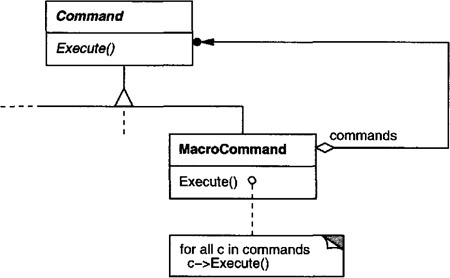Object-Oriented Programming
Design Pattern Command
Michael L. Collard, Ph.D.
Department of Computer Science, The University of Akron
Command
Encapsulate a request as an object, thereby letting you parameterize clients with different requests, queue or log requests, and support undoable operations
- Behavioral Pattern
- AKA: Action, Transaction
Command: Motivation
Paste Command
Open Command
Macro Command
Macro Command (GOF Diagram)

Command: Applicability
- Use the command pattern when you want to:
- Parameterize objects by an action to perform, as Menultem objects did above.
- Commands are an object-oriented replacement for callbacks.
- Specify, queue, and execute requests at different times
Command: Applicability
- Support undo.
execute()stores state for reversal,unexecute()reverses the effects of a previousexecute(). Executed commands are stored in a history list, with unlimited undo and redo - Support logging changes to reapply in case of a system crash
- Structure a system around high-level operations built on primitives operations, and support transactions
Command: Structure
Command: Participants
- Command - Declares an interface for executing an operation.
- ConcreteCommand (e.g., PasteCommand, OpenCommand)
- Defines a binding between a Receiver object and an action
- Implements
execute()by invoking the corresponding operation(s) on Receiver
Command: Participants
- Client (e.g., Application) Creates a ConcreteCommand object and sets its receiver
- Invoker (e.g., Menultem) Asks the command to carry out the request
- Receiver (e.g., Document, Application) Knows how to perform the operations associated with carrying out a request
Command: Collaborations
- The client creates a ConcreteCommand object and specifies its receiver
- An Invoker object stores the ConcreteCommand object.
- The invoker issues a request by calling
execute()on the command. When commands are undoable, ConcreteCommand stores state for undoing the command before invoking Execute. - The ConcreteCommand object invokes operations on its receiver to carry out the request.
Command: Consequences
- Command decouples the object that invokes the operation from the one that knows how to perform it
- Commands are first-class objects and can be manipulated and extended like any other object.
- Multiple commands can be assembled into a composite command (e.g., MacroCommand), and are instances of the Composite pattern
- Easy to add new Commands, because you don’t have to change existing classes.
Implementation
- How intelligent should a command be?
- Supporting undo and redo
- Avoiding error accumulation in the undo
- Using C++ templates to avoid creating Command subclasses
Related Patterns
- Composite
- Used to implement MacroCommands
- Memento
- Keep state the command requires for an undo
- Prototype
- Command is copied before being placed on a history list acts as a Prototype
